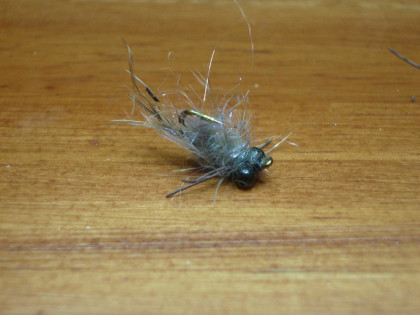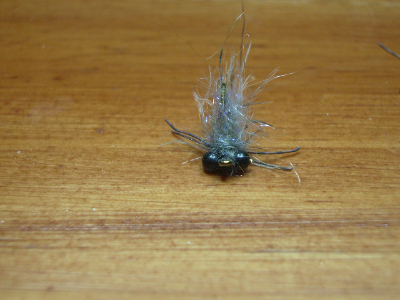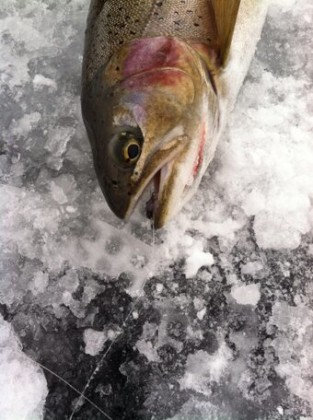Veteran ice fisherman have long known that scuds (or freshwater shrimp) are a favorite food for big panfish and trout under the ice. Over the past few seasons, I’ve been testing and tweaking a few patterns to match the hatch and create a good scud imitation. Crappies and bluegills under the ice have a much slower metabolism than their summer counterparts, so ice anglers need to utilize a few key triggers in their ice flies and lures to entice unaggressive, neutral fish into biting. These triggers hold true for not only ice flies, but all lures for hardwater panfish.

The ‘Gill Shrimp
The ‘Gill Shrimp (or “Bluegill Shrimp”) came about after refining a few patterns and adding materials and triggers to produce a convincing ice fly. I knew I wanted a bug that imitated the slightly curved position of a lethargic scud and had plenty of movement incorporated into the materials. I also really liked the oversized black bead chain eyes as the scud’s large eyes are a very noticable feature on the actual bug. After a few somewhat successful renditions, I finally settled on a version that utilized chickabou feathers and gray UV Ice Dub in a dubbing loop to produce a very life-like pattern with lots of inherent motion.
- Hook: #10-14 nymph or curved scud
- Thread: Black 6/0 UNI
- Tail: Natural gray chickbou and silver flashabou
- Rib: X-fine silver wire
- Body: Natural gray chickabou and gray UV Ice Dub in a dubbing loop, wrapped to eyes
- Legs: X-small brown centipede
A Few Thoughts on Triggers
A few key triggers came into play when designing the ‘Gill Shrimp. Profile is one major element in producing a bug that panfish will recognize. Fail to imitate the natural profile of the insect, and panfish will be far more reluctant to take your offering. Crappies and bluegills see thousands of these bugs in their natural environment through their lifetime, so imitating the general shape and proportions of the natural is key to producing a bait that panfish will recognize as a food source. An especially effective tactic is designing patterns around the life cycle when bugs are most vulnerable, such as a mayfly emergence or crayfish molt. Just like a trout will key in on crippled mayflies or a bass will readily attack a wounded baitfish, panfish will eagerly grab a bait that imitates an easy snack. Though profile is important, it isn’t the all-controlling factor in producing an effective bug. As long as the ice fly matches the broad general profile of the insect, you can utilize other triggers to entice fish into biting instead of focusing on imitating the exact profile of the natural. By grouping your ice flies into three general profiles (bloodworms and larvae, nymphs, and scuds) you can imitate a variety of specific insects with one general pattern.
Hatching A Match. Another factor to consider when designing flies and selecting baits is transparency. Scuds naturally have a translucent grayish, olive, or tan color depending on the body of water, so the flashy Ice Dub and picked-out chickabou legs are a good choice for creating a translucent appearance. Micro tubing does a nice job imitating the somewhat mottled color pattern of a mayfly nymph, as the clear hollow tubing allows some light to sneak through and produces a two-toned effect. Find the transparency of the bug you’re imitating and select your materials accordingly.

The large black eyes were the first component that I added to the ‘Gill Shrimp. The eyes on a scud are one of the more prominent features, providing a highly recognizable target for big panfish and trout to key in on when searching for scuds in the weedbeds. These identifiable elements such as the eyes on a scud or black spot on a shad can really get fish excited and push them into attack mode, so incorporating them into your ice flies and lures is an important part of triggering fish to strike.

Movement and Bugginess. Movement is perhaps the most important element in designing productive ice flies, so adding materials that have lots of natural movement is vital to creating an enticing pattern. Mini rubber legs have long been one of my absolute favorite materials for tying ice flies. The extra small, supple appendages add tons of natural movement and to a pattern, which is just what I want when slab panfish aren’t in the mood for an aggressive jigging cadence. Great for enticing negative cold-front panfish, they quiver and twitch with the slightest twitch of the rod tip, an essential element when finessing a large bluegill or crappie. But here’s where things get interesting. While the ‘Gill Shrimp possesses rubber legs that protrude straight out from the sides of the body at a perpendicular angle, freshwater shrimp and scuds do not actually have legs that extend outward, but instead curl in toward their stomach. Even though scuds don’t have these outward legs, the extra movement adds a trigger that I think really makes the difference between a decent pattern and a deadly one. With this in mind, matching the exact characteristics of an insect isn’t nearly as important as creating a buggy fly, which brings us back to profile. While imitating the profile and characteristics of the natural bug is important, extra triggers such as rubber legs or chickabou allow you to imitate several general bugs with one pattern. Depending on presentation and the mood and location of the fish, an ice fly might be taken for a scud, aquatic worm, or mayfly larvae, as it provides features of several bugs that fish will recognize. Panfish encounter hundreds of varieties of insects and larvae, so imitating an exact bug isn’t nearly as important as incorporating triggers into your ice flies and lures that will excite slab bluegills and crappies.
So there are a few thoughts on tying ice flies and triggers for winter panfish. The ‘Gill Shrimp and Slab Spike, which were designed with these triggers in mind, have been solid producers for me (if you don’t tie, you can grab a few hand-tied ‘Gill Shrimp and Slab Spike ice flies here). Using these natural triggers to your advantage when tying ice flies and selecting lures for hardwater panfish will lead to more fish on the ice, especially during tough cold-front situations.
Also check out our post on tying ice flies for more thoughts on designing and tying productive patterns.
Tight lines and good luck on the ice!
Conner
